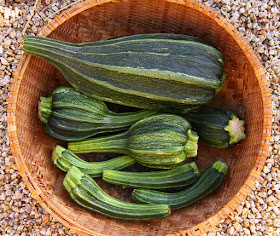So, on to the latest harvests. There's a couple of new items. The first harvest of Padron Peppers, pretty much on schedule, last year the first ones appear in my tally on July 20, and in 2013 on July 26. That's actually the second harvest of Sweet Gold cherry tomatoes.
 |
| Padron peppers and Sweet Gold cherry tomatoes |
Here's the first few cherry tomatoes from earlier in the week. The floodgates haven't exactly opened on the tomato harvest, but these few are a welcome treat. They came in earlier than last year but neck-and-neck with the first 2013 harvest. You can see that the cucumbers are coming in at a steady pace now.
 |
| Tasty Treat and Green Fingers cucumbers, Sweet Gold cherry tomatoes |
 |
| Green Fingers cucumbers |
 |
| Slenderette beans and Romanesco zucchini |
 |
| Royal Burgundy beans |
 |
| Red Baron beets |
The Spadona chicory produced another flush of leaves, 3 1/2 pounds in just a little over two weeks. I blanched the leaves and then sauteed some of them with pancetta and some garlic cream. I thought it was delicious, just mildly bitter, but Dave is much less tolerant of bitter flavors than I am, he ate what I served him but said the leftovers were all mine.
 |
| Spadona chicory and Romanesco zucchini |
 |
| Zebrune shallot and Red Candy Apple onion |
 |
| Rosso Lunga di Firenze onion |
The second variety of Spigariello broccoli that I'm trying this year is starting to produce nice shoots. This is similar to the Liscia (smooth leaf) broccoli that I grew earlier, the only real difference is that the leaves are more frilly. This bunch was blanched and paired with zucchini in a fritatta.
 |
| Spigariello Foglia Riccia broccoli |
I did a taste test of a mature green chickpea and found them to be tastier than expected, more like a fresh raw shelling pea than a bean. Can a vegetable be cute? I think these are.
 |
| Pico Pardal chickpea |
 |
| Pink Punch radish seed pods |
Here's the details of the harvests last week:
Rattlesnake beans - 1.7 oz. (48 g.)
Royal Burgundy beans - 1 lb., 6.9 oz. (649 g.)
Slenderette beans - 2 lb., 2.5 oz. (978 g.)
Red Baron beets - 13.5 oz. (383 g.)
Beet greens - 11.4 oz. (323 g.)
Spigariello Riccia broccoli - 9 oz. (255 g.)
Spadona chicory - 3 lb., 7.4 oz. (1571 g.)
Green Fingers cucumbers - 1 lb., 10.9 oz. (763 g.)
Tasty Treat cucumbers - 2 lb., 3.8 oz. (1015 g.)
Red Candy Apple onion - 1 lb., 3.3 oz. (547 g.)
Rossa Lunga di Firenze onion - 1 lb., .4 oz. (465 g.)
Padron peppers - 4.4 oz. (125 g.)
Zebrune shallot (trimmed) - 12.3 oz. (349 g.)
Sweet Gold cherry tomatoes - 3.1 oz. (88 g.)
Romanesco zucchini - 4 lb., 7.9 oz. (2038 g.)
Total harvests for the week - 23 lb., 9.2 oz. (10.69 kg.)
2015 YTD - 411 lb., .9 oz. (186.45 kg.)
Harvest Monday is hosted by Daphne on her blog Daphne's Dandelions, head on over there to be inspired by what other garden bloggers have been harvesting lately.






































